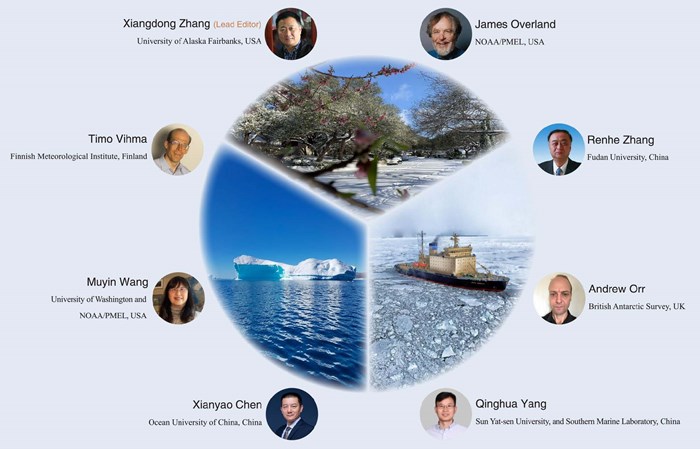北极气候系统的显著变化仍在持续:在过去的四十年里,北极地表及对流层低层的增温速率超过了全球增温速率的2倍,这种现象被称为北极放大效应(Arctic Amplification)。近十年的增暖趋势进一步加强,北极放大效应愈加明显。自有连续卫星观测以来,北极海冰范围在各季节均呈下降趋势,其中9月北极海冰范围平均每10年减少13.1%,且海冰冻结推迟至深秋甚至初冬开始。与此同时,北极大气和海洋动力过程也发生了显著变化,例如最近观测到的冬季波弗特高压崩溃、平流层极涡减弱、大西洋和太平洋增暖。而这些变化并不局限于北极,还与热带、中低纬度的气候和天气异常事件相关。
《大气科学进展》(AAS)曾在2017-2018年成功组织了“快速变化中的北极对欧亚地区气候和天气的影响”专刊https://link.springer.com/journal/376/volumes-and-issues/35-1。时隔四年,北极依然是学术界关注的热点,科学家们一直在努力理解、模拟和预测、预估北极的变化及其与中低纬度地区之间的相互作用。因此AAS再次组织“变化的北极气候及其与中低纬度地区天气、气候的联系”北极专刊,重点关注北极放大效应,以及北极与中低纬度地区气候和天气变化的关系。
编委团队:

专刊投稿截止日期:2022年9月1日
投稿网址: https://mc03.manuscriptcentral.com/aasiap
请选择专刊“Special issue: Arctic”
专刊具体信息如下:
Significant changes have continually occurred in the Arctic climate system. During last four decades, the Arctic surface/lower troposphere warming rate has been more than two times the global average, leading to a phenomenon of the Arctic Amplification (AA). In particular, the warming trend was elevated during most recent decade, further enhancing AA. Sea ice extent has decreased in all seasons with a declining rate of 13.1% per decade in September and 2.6% per decade in March, as well as a delaying of freeze-up into late fall or even early winter, during the last four decades. At the same time, Arctic atmosphere and ocean dynamic processes have also exhibited noted changes, for example, the recently observed collapse of the winter Beaufort high, more intense Arctic synoptic cyclones, weakening of the stratospheric polar vortex, and warmed Atlantic and Pacific layer water. The Arctic changes do not occur independently within the Arctic. They respond to remote forcing in the tropical and midlatitudes and translate to the low/mid-latitude climate and weather anomalies. Great efforts have been made to improve understanding, simulation, and prediction/projection of Arctic changes and the two-way interactions between the Arctic and lower latitudes. Especially, several internationally coordinated observational and modeling projects have recently been carried out, such as the Year of Polar Prediction (YOPP), Multidisciplinary drifting Observatory for the Study of Arctic Climate (MOSAiC), and Polar Amplification Model Intercomparison Project (PAMIP).
At the same time, Arctic atmosphere and ocean dynamic processes have also exhibited noted changes, for example, the recently observed collapse of the winter Beaufort high, more intense Arctic synoptic cyclones, weakening of the stratospheric polar vortex, and warmed Atlantic and Pacific layer water. The Arctic changes do not occur independently within the Arctic. They respond to remote forcing in the tropical and midlatitudes and translate to the low/mid-latitude climate and weather anomalies. Great efforts have been made to improve understanding, simulation, and prediction/projection of Arctic changes and the two-way interactions between the Arctic and lower latitudes. Especially, several internationally coordinated observational and modeling projects have recently been carried out, such as the Year of Polar Prediction (YOPP), Multidisciplinary drifting Observatory for the Study of Arctic Climate (MOSAiC), and Polar Amplification Model Intercomparison Project (PAMIP).
This special issue will provide a platform to publish latest progresses on Arctic climate system changes and their responses to/impacts on low/mid-latitude climate and weather anomalies. The consolidated publications on the topic in this special issue would facilitate synthesis of new research results, identify key scientific gaps, and hence contribute to a more thorough understanding of the problem. Submissions in, but not limited to, the following research areas, are invited:
-
Observed and simulated multi-scale changes, phenomena, and physical/feedback processes in and across interface of the Arctic atmosphere, sea ice, and ocean in the past, present and future;
-
Detection and attribution of two-way connections through the atmosphere, sea ice, and ocean between Arctic climate changes and low/mid-latitude climate and weather, including extreme events;
-
Assessment of predictability and evaluation of biases, errors and uncertainties in model simulations and predictions of Arctic climate/weather and Arctic-low/mid- latitude interactions.
Important dates:
Manuscript Submission Deadline: September 1, 2022.
Estimated publication time: Published online once accepted.
Final Print: Late winter 2022 or early 2023.
Submission URL: https://mc03.manuscriptcentral.com/aasiap
Please select: “Special issue: Arctic”
Please refer to the Author Guide for an MS Word template, Endnote reference style, and more detailed style instructions (http://www.iapjournals.ac.cn/aas/news/AuthorGuide.htm).
Advances in Atmospheric Sciences (AAS), launched in 1984, aims to rapidly publish the latest achievements and developments on the dynamics, physics and chemistry of the Earth’s atmosphere and ocean. It also aims to rapidly publish potentially high influential papers on the atmospheres of other planets and on earth system dynamics in which the atmosphere and/or ocean are involved. AAS is published by Springer and indexed by SCI database. For more information about AAS, please visit https://www.springer.com/376.
Do feel free to contact us on aas@mail.iap.ac.cn if you have any queries regarding the special issue.






